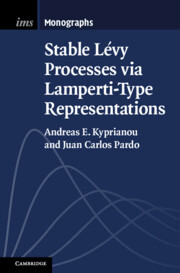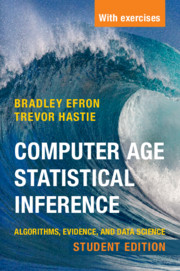Refine search
Actions for selected content:
2703 results in General statistics and probability
12 - Stable processes as self-similar Markov processes
-
- Book:
- Stable Lévy Processes via Lamperti-Type Representations
- Published online:
- 16 March 2022
- Print publication:
- 07 April 2022, pp 306-329
-
- Chapter
- Export citation
Preface
-
- Book:
- Stable Lévy Processes via Lamperti-Type Representations
- Published online:
- 16 March 2022
- Print publication:
- 07 April 2022, pp xix-xix
-
- Chapter
- Export citation
11 - Markov additive and self-similar Markov processes
-
- Book:
- Stable Lévy Processes via Lamperti-Type Representations
- Published online:
- 16 March 2022
- Print publication:
- 07 April 2022, pp 286-305
-
- Chapter
- Export citation
References
-
- Book:
- Stable Lévy Processes via Lamperti-Type Representations
- Published online:
- 16 March 2022
- Print publication:
- 07 April 2022, pp 446-457
-
- Chapter
- Export citation
8 - Asymptotic behaviour for stable processes
-
- Book:
- Stable Lévy Processes via Lamperti-Type Representations
- Published online:
- 16 March 2022
- Print publication:
- 07 April 2022, pp 206-226
-
- Chapter
- Export citation

Stable Lévy Processes via Lamperti-Type Representations
-
- Published online:
- 16 March 2022
- Print publication:
- 07 April 2022

Computer Age Statistical Inference, Student Edition
- Algorithms, Evidence, and Data Science
-
- Published online:
- 26 October 2021
- Print publication:
- 17 June 2021
-
- Textbook
- Export citation
20 - Many Servers with Abandonment
- from Part VI - Many-Server Systems
-
- Book:
- Scheduling and Control of Queueing Networks
- Published online:
- 01 October 2021
- Print publication:
- 14 October 2021, pp 346-359
-
- Chapter
- Export citation
12 - Processing Networks and Maximum Pressure Policies
- from Part IV - Fluid Models of Multi-Class Queueing
-
- Book:
- Scheduling and Control of Queueing Networks
- Published online:
- 01 October 2021
- Print publication:
- 14 October 2021, pp 197-218
-
- Chapter
- Export citation
4 - The G/G/1 Queue
- from Part II - Approximations of the Single Queue
-
- Book:
- Scheduling and Control of Queueing Networks
- Published online:
- 01 October 2021
- Print publication:
- 14 October 2021, pp 61-70
-
- Chapter
- Export citation
8 - Product-Form Queueing Networks
- from Part III - Queueing Networks
-
- Book:
- Scheduling and Control of Queueing Networks
- Published online:
- 01 October 2021
- Print publication:
- 14 October 2021, pp 125-142
-
- Chapter
- Export citation
18 - Infinite Servers Revisited
- from Part VI - Many-Server Systems
-
- Book:
- Scheduling and Control of Queueing Networks
- Published online:
- 01 October 2021
- Print publication:
- 14 October 2021, pp 323-329
-
- Chapter
- Export citation
Part VI - Many-Server Systems
-
- Book:
- Scheduling and Control of Queueing Networks
- Published online:
- 01 October 2021
- Print publication:
- 14 October 2021, pp 321-322
-
- Chapter
- Export citation
9 - Generalized Jackson Networks
- from Part III - Queueing Networks
-
- Book:
- Scheduling and Control of Queueing Networks
- Published online:
- 01 October 2021
- Print publication:
- 14 October 2021, pp 143-156
-
- Chapter
- Export citation
16 - Control in Balanced Heavy Traffic
- from Part V - Diffusion Scaled Balanced Heavy Traffic
-
- Book:
- Scheduling and Control of Queueing Networks
- Published online:
- 01 October 2021
- Print publication:
- 14 October 2021, pp 270-304
-
- Chapter
- Export citation
22 - Parallel Servers with Skill-Based Routing
- from Part VI - Many-Server Systems
-
- Book:
- Scheduling and Control of Queueing Networks
- Published online:
- 01 October 2021
- Print publication:
- 14 October 2021, pp 385-412
-
- Chapter
- Export citation
11 - Stability of MCQN via Fluid Limits
- from Part IV - Fluid Models of Multi-Class Queueing
-
- Book:
- Scheduling and Control of Queueing Networks
- Published online:
- 01 October 2021
- Print publication:
- 14 October 2021, pp 175-196
-
- Chapter
- Export citation
7 - Diffusions and Brownian Processes
- from Part II - Approximations of the Single Queue
-
- Book:
- Scheduling and Control of Queueing Networks
- Published online:
- 01 October 2021
- Print publication:
- 14 October 2021, pp 102-122
-
- Chapter
- Export citation
13 - Processing Networks with Infinite Virtual Queues
- from Part IV - Fluid Models of Multi-Class Queueing
-
- Book:
- Scheduling and Control of Queueing Networks
- Published online:
- 01 October 2021
- Print publication:
- 14 October 2021, pp 219-235
-
- Chapter
- Export citation
1 - Queues and Their Simulations, Birth and Death Queues
- from Part I - The Single Queue
-
- Book:
- Scheduling and Control of Queueing Networks
- Published online:
- 01 October 2021
- Print publication:
- 14 October 2021, pp 3-15
-
- Chapter
- Export citation
